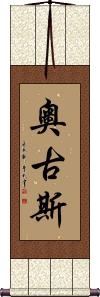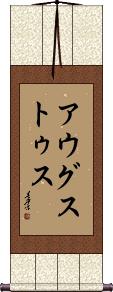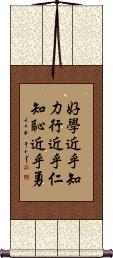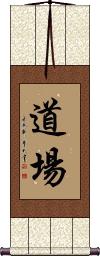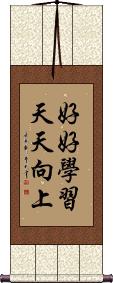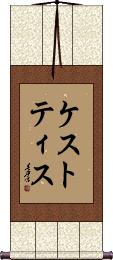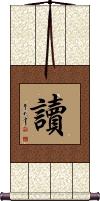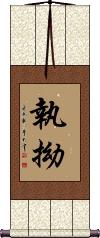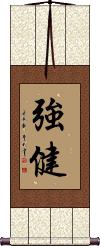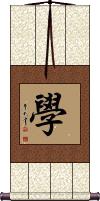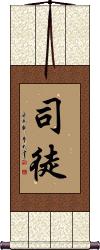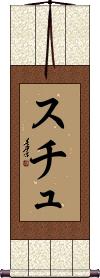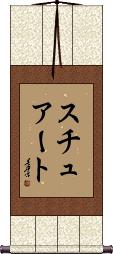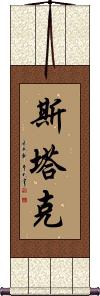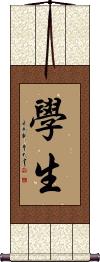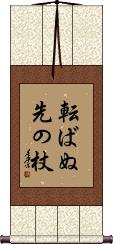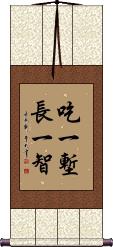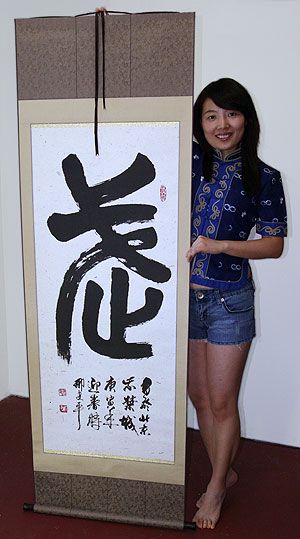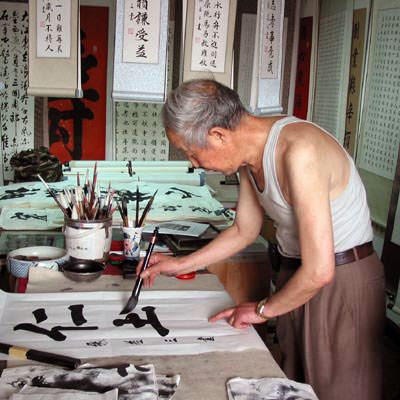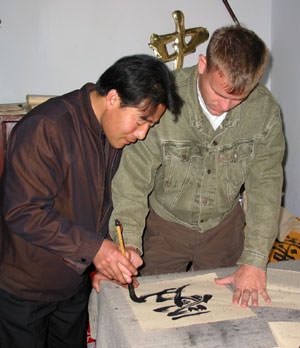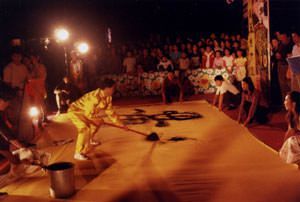The Name Stu in Japanese/Chinese on a Custom-Made Wall Scroll.
Click the "Customize" button next to your name below to start your personalized stu calligraphy artwork...
Switched to secondary search mode due to lack of results using primary.
These secondary results may not be very accurate. Try a different but similar meaning word or phrase for better results. Or...
Look up Stu in my Japanese Kanji & Chinese Character Dictionary(My dictionary is a different system then the calligraphy search you just tried)
If you want a special phrase, word, title, name, or proverb, feel free to contact me, and I will translate your custom calligraphy idea for you.
1. Asturia
2. Augustus
3. Learning leads to Knowledge, Study leads to Benevolence, Shame leads to Courage
6. Good Good Study, Day Day Up
7. Justus
8. Kestutis
9. Read / Study
11. Robust / Sturdy
13. Stu
14. Stuart
15. Stubblefield
16. Stubbs
17. Stuck
18. Stuckey
19. Student
20. Studer
21. Stull
22. Stultz
23. Stump
24. Stumpf
25. Sturdivant
26. Sturgeon
27. Sturgill
28. Sturgis
29. Sturm
30. Stutts
31. Stutz
32. Stutzenberger
33. Stutzman
34. Have a Walking Stick at the Ready Before You Stumble
35. Each Time You Stumble and Fall, You Gain Experience and Wisdom
Asturia
Augustus
Augustus
Learning leads to Knowledge, Study leads to Benevolence, Shame leads to Courage
Dojo / Martial Arts Studio
道場 is the Japanese term for a room or hall in which martial arts are taught.
道場 is often spelled “dojo” which has become a word in the English lexicon. However, the true Romaji is doujou or dōjō.
Please note: The Chinese definition of these characters is quite different. In Chinese, this is a place where Buddhist or Taoist mass is held. It could also be a place where spiritual or psychic events are performed.
Diligent Study Proverb
Drill a hole in the wall to get light to read by.
鑿壁偷光 is a Chinese proverb that means “Bore a hole in the wall to make use of the neighbor's light to study.”
This is a nice gift for a very studious person.
Kuang Heng was born during the Western Han period. He has been very fond of reading ever since he was young. However, he could not attend school since his family was poor, and he had to borrow books from people to learn.
To borrow these books, he normally did chores for people who had them. When he became older, he had to work in the field from sunrise to sunset since his family's financial situation did not improve. Thus, he tried to study at night, but he had no lamp.
One day, he noticed the light from the neighbor's house coming through a crack in the wall. This made him very happy, so he dug a larger hole from the crack and read in the light that shone through. This diligent study eventually made him an accomplished person.
Good Good Study, Day Day Up
好好學習天天向上 is a famous proverb by Chairman Mao Zedong that sounds really strange when directly translated into English.
I include it in our database of phrases to illustrate how different the construction and grammar can be between Chinese and English. The direct translation is “Good Good Study, Day Day Up.” In Chinese, a repeated character/word can often serve to reinforce the idea (like saying “very” or suggesting “a lot of”). So “good good” really means “a lot of good.” While “day day” can be better translated as “day in day out.” The idea of “up” has a meaning in China of “rising above” or “improving.”
After understanding all of this, we come up with a slightly better translation of “With a lot of good study, day in and day out, we raise above.”
The more natural translation of this proverb would be something like, “study hard, and keep improving.”
Justus
Justus
Kestutis
Kestutis
Read / Study
讀 is a Chinese character that means “to read out loud,” or “to study books.”
Very seldom used in Japanese anymore (except occasionally in Buddhism).
Relentless / Stubborn
執拗 means relentless or stubborn in Chinese, Japanese Kanji, and old Korean Hanja.
It can also be translated as willful, pigheaded, persistent, obstinate, tenacious, insistent, importunate, or persevering.
This is a rather negative word. it’s really inappropriate for a wall scroll, so please don’t order this unless you really want to shock Asian people who see it.
Robust / Sturdy
強健 means robustness or sturdiness in regards to being healthy and fit.
This can also be used to say “persistently good health.”
Study / Learn / School
學 is “study” or “learn” in Chinese, Japanese Kanji, and old Korean Hanja.
學 is a very broad character that can mean a lot of things related to scholarship. It can refer to a school (in fact, if you put the character for “big” in front of this, you have “college” or “university,” if you put the word for “middle,” you have “middle school.” This can also mean science; the process of acquiring knowledge; learning; scholarship; erudition; knowledge. It can also add the Chinese or Japanese version of “-ology” (the study of) too many words.
![]() There is a very common simplified version of this character. You will see this form in modern Japan and mainland China, Singapore, and other places. If you want this simplified version, please click on the character shown to the right instead of the "select and customize" button above.
There is a very common simplified version of this character. You will see this form in modern Japan and mainland China, Singapore, and other places. If you want this simplified version, please click on the character shown to the right instead of the "select and customize" button above.
Stuart
Stuart
Stubblefield
Stubblefield
Stubbs
Stubbs
Stuck
Stuck
Stuckey
Stuckey
Student
學生 is how to write “student” in Chinese, pre-WWII Japanese Kanji, and old Korean Hanja.
If you are a “student of life,” this might be an interesting wall scroll to hang in your reading room.
The first character means “study” or “learning.”
The second character means “life” or “birth.” Don't read too much into that second character unless you decide that this means “the birth of studies” or “the life of learning.” Everyone in China, Japan (and those who can read Hanja in Korea) will just read this word with the meaning of “student.”
If you put the character for “little” in front of this word, it becomes “elementary school student.” Prefixed with “middle,” it becomes “middle school student.” Prefixed with “big,” it becomes “university student” (though when these two characters for student are seen alone, it often suggests “university student”). The term “high school student” is written differently.
![]() There is a very common simplified version of the first character for this word. You will see this form in modern Japan and mainland China, Singapore, and other places. If you want this simplified version, please click on the character shown to the right instead of the "select and customize" button above.
There is a very common simplified version of the first character for this word. You will see this form in modern Japan and mainland China, Singapore, and other places. If you want this simplified version, please click on the character shown to the right instead of the "select and customize" button above.
Studer
Studer
Stull
Stull
Stultz
Stultz
Stump
Stump
Stumpf
Stumpf
Sturdivant
Sturdivant
Sturgeon
Sturgeon
Sturgill
Sturgill
Sturgis
Sturgis
Sturm
Sturm
Stutts
Stutts
Stutz
Stutz
Stutzenberger
Stutzenberger
Stutzman
Stutzman
Have a Walking Stick at the Ready Before You Stumble
転ばぬ先の杖 is a Japanese proverb that literally translates as: Have a walking stick ready before stumbling.
This is similar to the English idiom, “A stitch in time saves nine.”
In simple terms, this means: Always being prepared in advance.
Note: Because this selection contains some special Japanese Hiragana characters, it should be written by a Japanese calligrapher.
See Also: Fix Roof Before the Rain; Dig the Well Before You Are Thirsty
Each Time You Stumble and Fall, You Gain Experience and Wisdom
吃一塹長一智 is a Chinese proverb that means “Fall into a moat, and you will gain wisdom from the experience.”
It really suggests that the failures, troubles, frustrations, and setbacks that you encounter in your life are actually helping you to find wisdom. Some would also translate this proverb as “Learn from your mistakes” or “Learn from your experience.”
If you are studying Chinese, you will recognize the first character as “eat,” but in this case, it means to “experience” (as used in this proverb, it is suggesting that you have fallen into a moat and/or had a hard time crossing it).
Translated character by character, this whole proverb is, “Experience one moat, gain one wisdom/knowledge.”
Note: This can be pronounced in Korean, but it's not a commonly used phrase.
The following table may be helpful for those studying Chinese or Japanese...
| Title | Characters | Romaji (Romanized Japanese) | Various forms of Romanized Chinese | |
| Asturia | 阿斯圖里亞 阿斯图里亚 | ā sī tú lǐ yà a1 si1 tu2 li3 ya4 a si tu li ya asituliya | a ssu t`u li ya assutuliya a ssu tu li ya |
|
| Augustus | 奧古斯 奥古斯 | ào gǔ sī ao4 gu3 si1 ao gu si aogusi | ao ku ssu aokussu |
|
| Augustus | アウグストゥス | augusutotosu | ||
| Learning leads to Knowledge, Study leads to Benevolence, Shame leads to Courage | 好學近乎知力行近乎仁知恥近乎勇 好学近乎知力行近乎仁知耻近乎勇 | hào xué jìn hū zhī lì xíng jìn hū rén zhī chǐ jìn hū yǒng hao4 xue2 jin4 hu1 zhi1 li4 xing2 jin4 hu1 ren2 zhi1 chi3 jin4 hu1 yong3 hao xue jin hu zhi li xing jin hu ren zhi chi jin hu yong | hao hsüeh chin hu chih li hsing chin hu jen chih ch`ih chin hu yung hao hsüeh chin hu chih li hsing chin hu jen chih chih chin hu yung |
|
| Dojo Martial Arts Studio | 道場 道场 | dou jou / doujou / do jo | dào cháng dao4 chang2 dao chang daochang | tao ch`ang taochang tao chang |
| Diligent Study Proverb | 鑿壁偷光 凿壁偷光 | záo bì tōu guāng zao2 bi4 tou1 guang1 zao bi tou guang zaobitouguang | tsao pi t`ou kuang tsaopitoukuang tsao pi tou kuang |
|
| Good Good Study, Day Day Up | 好好學習天天向上 好好学习天天向上 | hǎo hǎo xué xí tiān tiān xiàng shàng hao3 hao3 xue2 xi2 tian1 tian1 xiang4 shang4 hao hao xue xi tian tian xiang shang | hao hao hsüeh hsi t`ien t`ien hsiang shang hao hao hsüeh hsi tien tien hsiang shang |
|
| Justus | 賈斯特斯 贾斯特斯 | jiǎ sī tè sī jia3 si1 te4 si1 jia si te si jiasitesi | chia ssu t`e ssu chiassutessu chia ssu te ssu |
|
| Justus | ジャスタス | jasutasu | ||
| Kestutis | 凱斯圖蒂斯 凯斯图蒂斯 | kǎi sī tú dì sī kai3 si1 tu2 di4 si1 kai si tu di si kaisitudisi | k`ai ssu t`u ti ssu kaissututissu kai ssu tu ti ssu |
|
| Kestutis | ケストティス | kesutotisu | ||
| Read Study | 讀 读 | doku | dú / du2 / du | tu |
| Relentless Stubborn | 執拗 执拗 | shitsu you / shitsuyou / shitsu yo | zhí niù / zhi2 niu4 / zhi niu / zhiniu | chih niu / chihniu |
| Robust Sturdy | 強健 强健 | kyouken / kyoken | qiáng jiàn qiang2 jian4 qiang jian qiangjian | ch`iang chien chiangchien chiang chien |
| Study Learn School | 學 学 | gaku | xué / xue2 / xue | hsüeh |
| Stu | 司徒 | sī tú / si1 tu2 / si tu / situ | ssu t`u / ssutu / ssu tu | |
| Stu | スチュ | suchu | ||
| Stuart | 斯圖亞特 斯图亚特 | sī tú yà tè si1 tu2 ya4 te4 si tu ya te situyate | ssu t`u ya t`e ssutuyate ssu tu ya te |
|
| Stuart | スチュアート | suchuaato / suchuato | ||
| Stubblefield | 斯塔布菲爾德 斯塔布菲尔德 | sī tǎ bù fēi ěr dé si1 ta3 bu4 fei1 er3 de2 si ta bu fei er de sitabufeierde | ssu t`a pu fei erh te ssutapufeierhte ssu ta pu fei erh te |
|
| Stubblefield | スタブルフィールド | sutaburufiirudo sutaburufirudo | ||
| Stubbs | 斯塔布斯 | sī tǎ bù sī si1 ta3 bu4 si1 si ta bu si sitabusi | ssu t`a pu ssu ssutapussu ssu ta pu ssu |
|
| Stubbs | スタッブス | sutabbusu | ||
| Stuck | 斯塔克 | sī tǎ kè si1 ta3 ke4 si ta ke sitake | ssu t`a k`o ssutako ssu ta ko |
|
| Stuck | スタック | sutakku / sutaku | ||
| Stuckey | 斯塔基 | sī tǎ jī si1 ta3 ji1 si ta ji sitaji | ssu t`a chi ssutachi ssu ta chi |
|
| Stuckey | スタッキー | sutakkii / sutaki | ||
| Student | 學生 学生 | gakusei | xué shēng xue2 sheng1 xue sheng xuesheng | hsüeh sheng hsüehsheng |
| Studer | 斯圖德 斯图德 | sī tú dé si1 tu2 de2 si tu de situde | ssu t`u te ssutute ssu tu te |
|
| Studer | ステューダー | suteuudaa / suteuda | ||
| Stull | 斯圖爾 斯图尔 | sī tú ěr si1 tu2 er3 si tu er situer | ssu t`u erh ssutuerh ssu tu erh |
|
| Stull | スタル | sutaru | ||
| Stultz | 斯圖爾茨 斯图尔茨 | sī tú ěr cí si1 tu2 er3 ci2 si tu er ci situerci | ssu t`u erh tz`u ssutuerhtzu ssu tu erh tzu |
|
| Stultz | スタルツ | sutarutsu | ||
| Stump | 斯圖姆普 斯图姆普 | sī tú mǔ pǔ si1 tu2 mu3 pu3 si tu mu pu situmupu | ssu t`u mu p`u ssutumupu ssu tu mu pu |
|
| Stump | スタンプ | sutanpu | ||
| Stumpf | 斯圖姆夫 斯图姆夫 | sī tú mǔ fū si1 tu2 mu3 fu1 si tu mu fu situmufu | ssu t`u mu fu ssutumufu ssu tu mu fu |
|
| Stumpf | スタンプ | sutanpu | ||
| Sturdivant | 斯特迪文特 | sī tè dí wén tè si1 te4 di2 wen2 te4 si te di wen te sitediwente | ssu t`e ti wen t`e ssutetiwente ssu te ti wen te |
|
| Sturdivant | スターディヴァント | sutaadivanto sutadivanto | ||
| Sturgeon | 斯特金 | sī tè jīn si1 te4 jin1 si te jin sitejin | ssu t`e chin ssutechin ssu te chin |
|
| Sturgeon | スタージョン | sutaajon / sutajon | ||
| Sturgill | 斯特吉爾 斯特吉尔 | sī tè jí ěr si1 te4 ji2 er3 si te ji er sitejier | ssu t`e chi erh ssutechierh ssu te chi erh |
|
| Sturgill | スターギル | sutaagiru / sutagiru | ||
| Sturgis | 斯特吉斯 | sī tè jí sī si1 te4 ji2 si1 si te ji si sitejisi | ssu t`e chi ssu ssutechissu ssu te chi ssu |
|
| Sturgis | スタージス | sutaajisu / sutajisu | ||
| Sturm | 斯特姆 | sī tè mǔ si1 te4 mu3 si te mu sitemu | ssu t`e mu ssutemu ssu te mu |
|
| Sturm | スターム | sutaamu / sutamu | ||
| Stutts | 斯圖茨 斯图茨 | sī tú cí si1 tu2 ci2 si tu ci situci | ssu t`u tz`u ssututzu ssu tu tzu |
|
| Stutts | スタッツ | sutattsu | ||
| Stutz | 斯圖茨 斯图茨 | sī tú cí si1 tu2 ci2 si tu ci situci | ssu t`u tz`u ssututzu ssu tu tzu |
|
| Stutz | スタッツ | sutattsu | ||
| Stutzenberger | 斯圖岑伯格 斯图岑伯格 | sī tú cén bó gé si1 tu2 cen2 bo2 ge2 si tu cen bo ge situcenboge | ssu t`u ts`en po ko ssututsenpoko ssu tu tsen po ko |
|
| Stutzenberger | スタッツェンバーガー | sutattsenbaagaa sutattsenbaga | ||
| Stutzman | 斯圖茲曼 斯图兹曼 | sī tú zī màn si1 tu2 zi1 man4 si tu zi man situziman | ssu t`u tzu man ssututzuman ssu tu tzu man |
|
| Stutzman | スタッツマン | sutattsuman | ||
| Have a Walking Stick at the Ready Before You Stumble | 転ばぬ先の杖 | koro ba nu saki no tsue korobanusakinotsue | ||
| Each Time You Stumble and Fall, You Gain Experience and Wisdom | 吃一塹長一智 吃一堑长一智 | chī yí qiàn, zhǎng yí zhì chi1 yi2 qian4 zhang3 yi2 zhi4 chi yi qian zhang yi zhi chiyiqianzhangyizhi | ch`ih i ch`ien chang i chih chihichienchangichih chih i chien chang i chih |
|
| In some entries above you will see that characters have different versions above and below a line. In these cases, the characters above the line are Traditional Chinese, while the ones below are Simplified Chinese. | ||||

